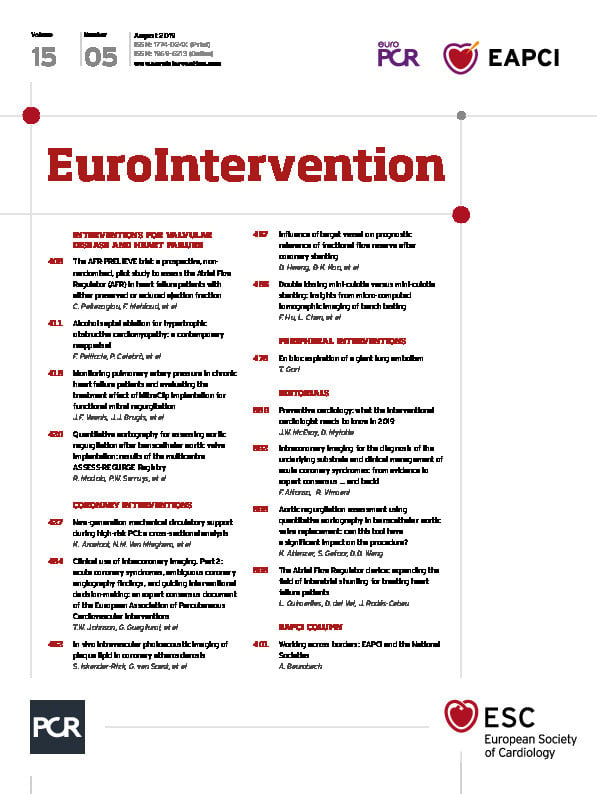
At the annual meeting of the European Society of Cardiology in Paris this year, interventional cardiologists may find occasion to attend sessions not related to their own subspecialty. On such occasions, one often finds that innovation in cardiovascular medicine is not limited to the interventional arena. While the turn of the millennium brought with it some concerns that advances in cardiovascular medicine could be faltering1, new device technologies have since generated a renaissance of sorts in cardiovascular innovation2,3,4. In fact, a similar rejuvenation is happening in preventive cardiology.
Given the pace of discovery in cardiovascular medicine, however, the modern canon has become far too vast for any one individual to master. Hence, the interventional community may not be aware of important advances in preventive cardiology. Herein, we provide a summary (in ABCD format) of pertinent preventive cardiology “news” for the busy interventionalist. A more comprehensive and lengthy review for the subspecialty cardiologist interested in, but not focused on, preventive cardiology can be found elsewhere5,6.
A – Assessment of risk and aspirin (with particular reference to primary prevention)
Prognostic tools such as the traditional Framingham Risk Score remain central to the appropriate allocation of primary prevention treatments. For example, it makes little sense to give newly developed, and often expensive, preventive medicines to low-risk primary prevention individuals who would be better served with lifestyle modification and/or generics. The current recommendation is to use the Pooled Cohort Equations or the SCORE Equation7. These scores can be found online, and both have mobile applications to facilitate use in a busy clinical setting. It is, however, increasingly recognised (and obvious to most) that these prediction scores can be significantly inaccurate in any given individual. Thus, more personalised tools such as coronary calcium are increasingly recommended and are available at low cost and radiation exposure (the latter less than a mammogram)8.
When considering risk reduction, aspirin is no longer recommended for primary prophylaxis against heart attack or stroke given the lacklustre results in three large randomised trials in 2018 for this indication9. Some individualised decision making is still reasonable in very high-risk primary prevention adults and, of course, aspirin remains a mainstay of secondary prevention.
B – Blood pressure
Importantly, both American and European guidelines now recommend that high-risk adults (particularly the secondary prevention patients seen by interventionalists) should be treated to a blood pressure (BP) target of 130/80 mmHg (where possible without undue side effects). Thus, it is no longer acceptable to “kick the can down the road” and to succumb to therapeutic malaise. There are some distinctions between US and EU guidelines, but the take-home message is as follows: if a high-risk patient’s BP is even one point above 140 mmHg systolic, we must act and try to reduce it to 130/80 mmHg. A 24-hour ambulatory BP test is useful before pulling the trigger on medication adjustment. Blood pressure kills silently, and it is essential for cardiologists to treat where appropriate.
In terms of new developments in BP, there are many, but three are worth highlighting. First, it is now well established that most hypertension that has been labelled “resistant” stems from poor compliance with prescribed medications. Thus, it is worth digging deep with the patient on this issue and having a high index of suspicion before simply adding in yet another medication that the patient will not take. Second, we probably now have a new class of antihypertensive, the SGLT-2 inhibitor. We will need to become familiar with these drugs. More details are provided below in the section on diabetes. Third, and perhaps most interesting to the interventional cardiologist, renal denervation is back on the scene. New sham-controlled studies of the Spyral™ catheter (Medtronic, Dublin, Ireland) have confirmed a true effect on BP lowering10. The magnitude of this effect is in the order of a 10-15 mmHg reduction for most patients, so, assuming that confirmatory studies lead to regulatory approval of this technology, this invasive treatment option may not be viable for those with severe hypertension. Rather, a more important role for this technology may be in adults with mild hypertension who really do not want to (or cannot) take medications.
C – Cholesterol
We are back to low-density lipoprotein (LDL) cholesterol targets. For secondary prevention catheterisation lab patients, this target is 70 mg/dL or 1.8 mmol/L. Most patients are not at this target, so it is reasonable for all interventional cardiologists to ensure that eligible patients are prescribed high-intensity statins before they leave the hospital. LIPITOR® (Pfizer, New York, NY, USA) 20 mg does not cut it for most patients; a 40 mg dose is more appropriate as a minimum (or the equivalent dose of an alternative statin).
For the patient with premature coronary disease, a strong family history, but normal lipid profile, we should check the lipoprotein “little” A (Lp[a]) level. This is a predominantly inherited condition that is not picked up on a routine lipid panel. Statins do not treat this and may actually increase the Lp[a] level. New PCSK9 injectables do reduce it, though the message for interventionalists should be simply to think about screening patients for elevated Lp[a] in cases with coronary disease more severe than the traditional risk factors would suggest (particularly when there is also a family history). Those with an Lp[a] ≥50 mg/dL (125 nmol/L) warrant referral to a preventive cardiologist.
There have been dramatic developments in lipid therapeutics in recent years. PCSK9 inhibitors are blockbusters11 and will further help to justify the preventive cardiologist’s existence (the first author is a preventive cardiologist!). These injectable mono-clonal antibodies are safe but typically require specialist referral for access (mostly because of reimbursement barriers due to high cost). Triglycerides also finally have an evidence-based treatment. So, the interventionist should, in our view, now forget about fibrates and instead think about high-dose omega 3 supplementation (specifically when triglycerides remain elevated after first attempting to lose weight). In the REDUCE-IT study, 4 g/day (2 g twice daily) of purified eicosapentaenoic acid (EPA) resulted in dramatic benefits12 and, while confirmatory studies are still ongoing, there seems little reason not to use EPA in scenarios where fibrates would traditionally have been considered for hypertriglyceridaemia (noting that there is little if any proof of cardiovascular benefit from fibrates). Last, but not least, a new alternative to statins (bempedoic acid) is on the horizon13. It acts in the same way as statins do but does not get into muscle cells, hence no myalgias (the Achilles’ heel of statins). An outcome trial is underway; therefore, this therapy may not be available for two or more years. Bempedoic acid is unfortunately not as potent as statins, but a combination of ezetimibe and bempedoic acid might serve as a very useful alternative to statins.
D – Diabetes
Recently, we have witnessed a sea change in the management of type 2 diabetes, particularly with respect to cardiovascular risk reduction14. New agents with now well-established cardiovascular benefits include GLP-1 agonists and SLGT-2 inhibitors15. The former class of agents is mostly injectable (though results using an oral version have just been published16) and is thought to benefit the heart primarily through reducing atherosclerosis progression. The latter, SGLT-2 inhibitors, are oral medications and have a diuretic and blood pressure-lowering effect. While SGLT-2 inhibitors reduce cardiovascular disease, a prominent part of their benefit is in heart failure reduction. Although the interventional cardiologist may not yet be reaching to prescribe GLP-1 agonists or SLGT-2 inhibitors, awareness of the benefits of these agents, and hence discussion with our colleagues in preventive cardiology and diabetes medicine, can improve outcomes for our patients.
We hope this quick update is useful for the busy interventional cardiologist and prompts ongoing discussion with our colleagues in preventive cardiology. Optimal patient care should not end when the patient leaves the cath lab.
Conflict of interest statement
The authors have no conflicts of interest to declare.

